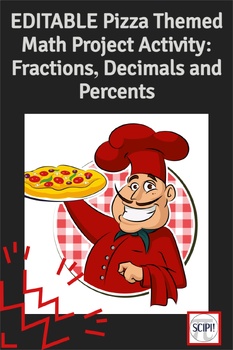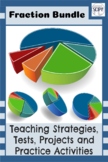EDITABLE Pizza Themed Math Project Activity Fractions, Decimals and Percents
- Word Document File
Also included in
- This fraction bundle of 13 resources incorporates strategies on how to teach fractions, reduce fractions, work with simple percents, recognize equivalent fractions, find LCM and GCF in addition to adding, subtracting, multiplying and dividing fractions. It contains two EDITABLE projects, four EDITABPrice $35.80Original Price $43.80Save $8.00
Description
This is an EDITABLE summative math assessment with the theme of pizza and comprises seven questions that center on fractions, decimals, and percents. It may be given as a final test, summative project or self-guided learning activity and is perfect for distance learning. The seven questions use three levels of Bloom’s Taxonomy (remembering, understanding and applying). Specific student directions are provided, and three boxes of a sample project are included in the students’ three page handout. The answer key and a seven point grading rubric are added for the teacher. Students are given the option of presenting the project in a variety of ways, including using a power point.
This document is not saved in PDF so that the teacher may adapt it as needed.
Also available is an alternative fraction summative assessment.
Below are other fraction assessments available at my store.
- Fractions: A Cumulative Math Test (all operations)
- Fractions, Decimals and Percents: A Chapter Test
- Fractions: An Introductory Test
- Fraction Summative Project with a Pizza Theme
Do you need some alternative ways to teach fractions? Check out the resources below:
- Fractions for the Confused and Bewildered
- Using Digital Root and the Divisibility Rules to Help Reduce Fractions
- Finding the Greatest Common Factor and Least Common Multiple Using a Venn Diagram
Also available on TPT is an 86 page fraction bundle:






